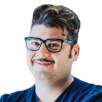One of the companies featured at this year’s DDS.Berlin event is NextDent by 3D Systems, an industry leader in 3D printing solutions that help enhance tasks in dental laboratories and practices. As well as exhibiting their latest products and innovations in the field of 3D printing, the company also hosted a free workshop, titled “The future of 3D fental printing by NextDent,” which immersed participants in the theory and practice of this specific industry. Connie Peterse-van der Koppel, the principal scientific advisor and person responsible for regulatory compliance (PRRC) at NextDent by 3D Systems, sat down with Dental Tribune International, to discuss the company’s current innovations and their vision for the future.
Mrs Peterse-van der Koppel, I understand that you have a deep and longstanding connection to NextDent. Could you elaborate on your personal journey within the company?
Actually, I'm one of the founders of the NextDent organisation. 2010 was really the starting point for us as far as setting up digital dentistry is concerned and in fact we were one of the first companies to have innovated certified materials to be used in a printer and actually having a biologically safe, clinical performing device. So that's essentially my background and these days my main role as the principal scientific advisor in the organisation is to provide advice to the board of management regarding which direction we should be moving in and which trends are important. It's about understanding what’s new and figuring out what the market needs, which are very important aspects of our business.
What does DDS.Berlin mean for NextDent by 3D Systems and what has your experience of the event been so far?
For us digital dentistry is not something new, since we have multiple congresses on the topic all over the world. I think that DDS.Berlin is an important gathering of scientific and industry groups to discuss and figure out what everybody is doing and also to see what new trends are on the horizon. Unlike some of the other larger conferences where there is a more general focus, this event is a great opportunity to really have the focus squarely on digital. Everybody who comes to DDS.Berlin is focused on digital, so the conversations you have, the meetings you have, the questions you get, are all related to the topic. This allows all of the companies here to really pinpoint their portfolio, products and strategies, which I think is very important.
Here at DDS.Berlin, you hosted a hands-on workshop called “The future of 3D dental printing.” Could you elaborate upon the workshop and what new skills and knowledge participants learned?
To begin with, the workshop covered the whole trajectory of digital dentistry: where it came from, what is the current state of play, and also what future position it is moving towards. As well as that, we also wanted to clarify some of the technical aspects of 3D printing for participants. There are a lot of printers out there on the market, but we wanted to really delve into the crucial issue of how this technology needs to create something which clinically performs. For example, there are devices which may produce something that aesthetically looks like a denture but doesn't have the same definition or perform effectively. These are some of the fundamental issues within the realm of 3D printing that we communicated to our participants.
How do you see the future of digital dentistry? Do you see it moving in any particular direction?
Yes. No doubt. Digital dentistry entered a boom period between 2014 and 2019 where a lot of opportunistically minded companies got in and then got out again. Today, however, what we have is a serious professional league of players, taking the patient seriously, knowing that it's all about safety for the patient, clinically performing devices, and figuring out there's so much more to gain from the benefits of 3D printing. Digital dentistry is here to stay and don't underestimate its positive effect for the lab owner in terms of efficiency, but also to compensate for the fact that we have less technicians these days in Europe but still need to have somebody to create the devices for the patients. So from my perspective digital dentistry is a win-win scenario. The bar is always getting set higher in terms of the quality of health care.
Finally, are there currently any specific products or innovations that are especially significant for NextDent by 3D Systems?
In the past few months there have been two developments that are interesting. The first is that we have developed the new denture-based material called NextDent Base, which utlilises hybrid systems and tough material, and which also facilitates the printing of partial dentures. I think making partials is a complex process that really can benefit from having it be printed instead of constructed conventionally. The second crucial innovation for our company is the NextDent 300 MJP (MultiJet Printing) printer which contains the power to produce the full denture. In this case, the full denture is coming out of the machine and the only thing required is to melt the wax off and polish it, a short procedure that yields a final device. Both of these developments are of special significance for us and will be for years to come.
Topics:
Tags:
ROCK HILL, S.C., US: Expanding its robust portfolio of materials and 3D-printing solutions for clinicians and dental laboratories, 3D Systems has announced ...
DAMMAM, Saudi Arabia: The method of denture fabrication and material used are relevant to longevity, strength and occlusal wear resistance. 3D-printing ...
BUDAPEST, Hungary: The use of additive manufacturing in dentistry is widespread in dental markets; however, there is a lack of information about the ...
FORT WORTH, Texas, U.S.: Owing to the growing popularity of point-of-care 3D printing and the subsequent creation of 3D-printing laboratories, a recent ...
Live webinar
Tue. 2 July 2024
3:00 pm EST (New York)
Dr. Francesco Giachi Carù
Live webinar
Wed. 3 July 2024
1:00 pm EST (New York)
Prof. Aggr. Gianna Maria Nardi - Presidente ATASIO
Live webinar
Thu. 4 July 2024
1:00 pm EST (New York)
Live webinar
Thu. 18 July 2024
8:00 pm EST (New York)
Live webinar
Tue. 6 August 2024
6:00 pm EST (New York)
Live webinar
Tue. 13 August 2024
7:00 pm EST (New York)
Live webinar
Wed. 28 August 2024
8:00 pm EST (New York)



 Austria / Österreich
Austria / Österreich
 Bosnia and Herzegovina / Босна и Херцеговина
Bosnia and Herzegovina / Босна и Херцеговина
 Bulgaria / България
Bulgaria / България
 Croatia / Hrvatska
Croatia / Hrvatska
 Czech Republic & Slovakia / Česká republika & Slovensko
Czech Republic & Slovakia / Česká republika & Slovensko
 France / France
France / France
 Germany / Deutschland
Germany / Deutschland
 Greece / ΕΛΛΑΔΑ
Greece / ΕΛΛΑΔΑ
 Italy / Italia
Italy / Italia
 Netherlands / Nederland
Netherlands / Nederland
 Nordic / Nordic
Nordic / Nordic
 Poland / Polska
Poland / Polska
 Portugal / Portugal
Portugal / Portugal
 Romania & Moldova / România & Moldova
Romania & Moldova / România & Moldova
 Slovenia / Slovenija
Slovenia / Slovenija
 Serbia & Montenegro / Србија и Црна Гора
Serbia & Montenegro / Србија и Црна Гора
 Spain / España
Spain / España
 Switzerland / Schweiz
Switzerland / Schweiz
 Turkey / Türkiye
Turkey / Türkiye
 UK & Ireland / UK & Ireland
UK & Ireland / UK & Ireland
 Brazil / Brasil
Brazil / Brasil
 Canada / Canada
Canada / Canada
 Latin America / Latinoamérica
Latin America / Latinoamérica
 USA / USA
USA / USA
 China / 中国
China / 中国
 India / भारत गणराज्य
India / भारत गणराज्य
 Japan / 日本
Japan / 日本
 Pakistan / Pākistān
Pakistan / Pākistān
 Vietnam / Việt Nam
Vietnam / Việt Nam
 ASEAN / ASEAN
ASEAN / ASEAN
 Israel / מְדִינַת יִשְׂרָאֵל
Israel / מְדִינַת יִשְׂרָאֵל
 Algeria, Morocco & Tunisia / الجزائر والمغرب وتونس
Algeria, Morocco & Tunisia / الجزائر والمغرب وتونس
 Middle East / Middle East
Middle East / Middle East
:sharpen(level=0):output(format=jpeg)/up/dt/2024/06/Shutterstock_1677222151.jpg)
:sharpen(level=0):output(format=jpeg)/up/dt/2024/06/Popularity-of-intra-oral-scanners-poised-to-soar-in-Latin-America-3.jpg)
:sharpen(level=0):output(format=jpeg)/up/dt/2024/06/At-SHINING-3D-our-aim-is-to-enhance-the-lives-of-dental-professionals-through-cutting-edge-technology.jpg)
:sharpen(level=0):output(format=jpeg)/up/dt/2024/06/file-3.jpg)
:sharpen(level=0):output(format=jpeg)/up/dt/2024/06/DDS.Berlin-Introducing-Medits-new-product-the-Medit-i900-1.jpg)








:sharpen(level=0):output(format=png)/up/dt/2023/03/ACTEON_NEW-logo_03-2024.png)
:sharpen(level=0):output(format=png)/up/dt/2014/02/kuraray.png)
:sharpen(level=0):output(format=png)/up/dt/2021/02/logo-gc-int.png)
:sharpen(level=0):output(format=png)/up/dt/2011/11/ITI-LOGO.png)
:sharpen(level=0):output(format=png)/up/dt/2014/02/FKG.png)
:sharpen(level=0):output(format=jpeg)/up/dt/2024/06/file-3.jpg)

:sharpen(level=0):output(format=jpeg)/up/dt/2024/06/Shutterstock_1677222151.jpg)
:sharpen(level=0):output(format=gif)/wp-content/themes/dt/images/dt-user.gif)
:sharpen(level=0):output(format=jpeg)/up/dt/2023/04/New-products-from-3D-Systems-Empowering-dental-professionals-and-improving-the-patient-experie.jpg)
:sharpen(level=0):output(format=jpeg)/up/dt/2023/02/3D-printed-denture-teeth-suitable-for-long-term-clinical-use-.jpg)
:sharpen(level=0):output(format=jpeg)/up/dt/2022/03/3D-printing-Study-examines-dentists-use-experience-and-spending-1.jpg)
:sharpen(level=0):output(format=jpeg)/up/dt/2020/09/Study-highlights-benefits-of-in-house-3D-printing-for-immediate-dental-implant-placement.jpg)





:sharpen(level=0):output(format=jpeg)/up/dt/2024/06/Shutterstock_1677222151.jpg)
:sharpen(level=0):output(format=jpeg)/up/dt/2024/06/Popularity-of-intra-oral-scanners-poised-to-soar-in-Latin-America-3.jpg)
:sharpen(level=0):output(format=jpeg)/up/dt/2024/06/At-SHINING-3D-our-aim-is-to-enhance-the-lives-of-dental-professionals-through-cutting-edge-technology.jpg)
:sharpen(level=0):output(format=jpeg)/wp-content/themes/dt/images/3dprinting-banner.jpg)
:sharpen(level=0):output(format=jpeg)/wp-content/themes/dt/images/aligners-banner.jpg)
:sharpen(level=0):output(format=jpeg)/wp-content/themes/dt/images/covid-banner.jpg)
:sharpen(level=0):output(format=jpeg)/wp-content/themes/dt/images/roots-banner-2024.jpg)
To post a reply please login or register